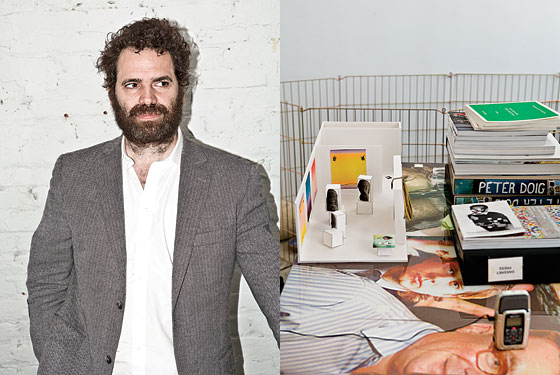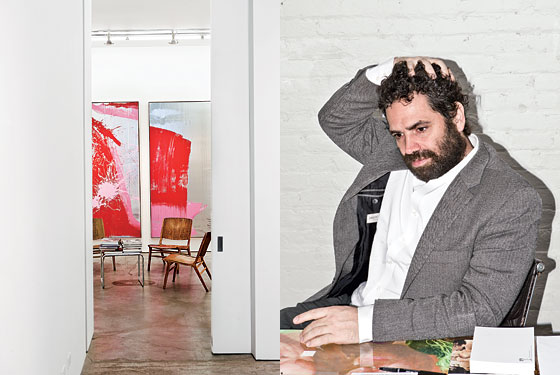
Gavin Brown’s Enterprise is on Greenwich Street in the still-industrial-feeling area that is neither Soho nor the West Village. The building is a former meat-processing plant, and it takes up the entire block. “I don’t know anyone else who has a whole block,” Brown says as he walks the perimeter of his gallery with his dog, Dotti. He is nearly 50, he has three kids, and here with Dotti on a leash he looks like the kind of liberal-arts professor who would quietly ask the undergrads if they knew where he might score some pot.
But why a whole block, anyway?
“Because it was for rent,” Brown says, and then smiles. He’s being cute about it. Sure, it was for rent, but what is far more interesting is that Brown was in the position to rent it because he has been, over the past decade, an enormous commercial success, the majordomo of an art-world clique that is currently passing from cool kid to Establishment.
It’s a tricky line to walk, and it’s not clear which side of it Brown is on these days. And perhaps his success depends upon the whole thing remaining blurry.
Undeniably, Brown sells a huge amount of very expensive art. His roster includes highly collectible artists like Alex Katz and Elizabeth Peyton, but also Rirkrit Tiravanija, who’s been known to serve dinner as art. And now the bulk of his space is occupied by a work by Frances Stark in which the text of her online flirting and sex chats with Italian strangers (“mmmmm,” “omg”) is projected onto walls in sync to Don Giovanni.
“I wake up in the morning thinking, What a great way to make a living,” Brown says. “Artists are the most important members of our society. So success is how much their communication is being received, understood by other human beings … Rirkrit did a model of my gallery in the Whitney Biennial, and I guess a lot of it is feeling a sense of pride. Not that you’ve done it but that somehow you’re in the orbit of something you believe will continue to have some positive effect on our ability to survive. But, of course, I’m not going to say that I like a painting because I’ve got a good chance of selling it.”
Brown first came to New York from England in 1988 as an artist in the prestigious Whitney Museum program. The only problem was that he decided his art, which he says was “proto-conceptual,” was no good. “I couldn’t ever quite suspend disbelief. I looked at these things, and they felt empty to me. I made a practical decision. I wasn’t selling any art, so I had to make money.”
He opened his first gallery in a tiny Soho space. Then, in 1997, he opened a gallery on West 15th Street with a bar called Passerby attached whose floor itself was a work of art by Piotr Uklanski. Like the floor in Saturday Night Fever, it changed color in response to the thumping music. Passerby was the center of things for a while. There was lots of Chloë Sevigny and Moby stopping by for drinks.
“That’s beyond ancient history to me,” he says. “I’m not interested in nostalgia. But I will say that I hadn’t found the New York I was interested in.” So he made his own—though “I guess it’s a strange thing for a misanthrope to open a bar.”
He’s being cute again, because another key to the Gavin Brown ascendancy is his parties; Mary Boone wielded as much power from her perch at Mr. Chow as she did from her gallery, and Brown is often front and center in the social realm, throwing dinners to which most of Chelsea would like to be invited. “I like hanging out with my friends, you know? I get lonely. We’re social animals.”
Brown is so socially entrenched that his close ties with the New Museum—he represents Verne Dawson, the husband of onetime New Museum curator Laura Hoptman—led to whispers that he was part of some art-world cabal after the museum held solo shows for his artists Urs Fischer and Peyton.
“Boring,” Brown says. “Small-minded bean counters. How’s that for a good quote? I mean, the whole thing is so insulting to the artists, that they got those shows because of some relationship that I may have had with a curator.”

The social prominence, the roster—it’s natural that Brown is often considered the heir to Larry Gagosian’s gallery crown, but he demurs. “I think what he’s doing is extraordinary because he’s managing to have all the plates spinning,” Brown says of the dark prince on whose empire—eleven galleries around the world—the sun, famously, never sets. “It’s an ambition that doesn’t appeal to me. I don’t have a messianic streak. I have an enormous ambition for art and communication, and I don’t necessarily see that scale as adding anything. I’m kind of in awe of how he’s pinning the marketplace down. But there’s this tension between what it is we’re looking at—is it the effect of money? Or the power of culture? He’s as interesting as any of the artists he shows. I guess I should want it, but I think there are other ways. Other gold standards. I was just listening to the minister of happiness from Bhutan talk about time management on the radio and—what was the word?”
An hour later there’s a text from Brown: “Mindfulness.”